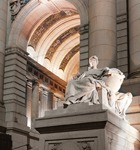The Alexander Hamilton US Custom House, completed in 1907, is a prime example of a 1900s beaux arts building in New York City. It currently houses the Smithsonian’s National Museum of the American Indian and the US Bankruptcy Court for the Southern District of New York, and it is under the stewardship of the US General Services Administration (GSA). In 2005, RS Lighting Design was hired to design a cohesive update of the iconic building’s lighting system, one that would increase energy efficiency while reducing maintenance costs. The firm completed the project in 2007 for the building’s centennial, and the structure now stands as a prime example of the latest lighting technology and design standards—standards including optimum illumination of three dimensional objects and a focus on lighting direction, color, and how the building looks at night. Randy Sabedra, president of RS Lighting, took gb&d on a tour of the myriad techniques used to illuminate the historic building.

RS Lighting Design’s central concept for the US Custom House was to light it dramatically from below, creating complex shadows. Photo: Tom La Barbera / Picture This Studio, enhanced by Dave Deacon Studios.
gb&d: What challenges did you face with this project?

Warm key light and backlight—and cool fill light—play up this sculpture’s unique design and intricate elements from all viewing angles. Photo: Tom La Barbera / Picture This Studio, enhanced by Dave Deacon Studios.
Randy Sabedra: The building was lit several times over the past 15 years, but very piecemeal. There never was a cohesive design, and the façade was lit poorly by giant—and very visible—1,000-watt floodlights. One goal was to remove the presence of lighting equipment and enhance the overall presence in the urban landscape. Even though the building was occupied during the day, everyone left by 5 or 6 p.m., and the interior lights were all turned off at night, and all you saw were dark windows all night long. My goal was to make it look like the rooms were occupied at night. They needed to glow as though light was coming out from them. While improving the nighttime presence was primary, the renovation opened an opportunity to reduce energy and maintenance costs.
gb&d: What light source did you use for the façade?
RS: I used two different systems. There are lights that are very close and attached to the building that gaze upward or provide accent. Most of these are LEDs with some metal halides, and their warm color creates the highlights and shadows. Across the street, on a neighboring building, there are floodlights that cast a cool light that I refer to as “moon glow.” These helped to fill in the shadows. This interplay of cool and warm defined the form.
gb&d: What are your concerns with the use of LEDs?
RS: LEDs were a perfect choice for this application. If the primary goal was to reduce energy, we could have done this quite effectively and within the benchmark with fluorescent or halide sources. But the scale of these fixtures gets big. While LED sources can reduce energy and save maintenance costs, most of these LED products are disposable. There’s no lamp to change. LED sources have a rated life of 50,000 hours; however, this rated life is a very slow death, and as the light output decreases or the colors shift, you have to replace the whole fixture. It was tricky to suggest to an owner that we’re going to put up all these fixtures, then in 10 to 15 years, when it’s time to replace all these light sources, you have to replace the whole fixture. Fortunately, I had the backing of the LED fixture and source manufacture—and lead benefactor—behind me; we did replace several fixtures during construction and have plans to replace additional fixtures this summer.
gb&d: The exterior has a European look to it. How did you achieve it?
RS: We [in America] tend to just want to floodlight buildings and fear shadows, but light is used in a more dramatic way on ornate European buildings. The US Custom House is more sculpture than façade. … In the theatrical world, when you want to define the depth in a space, one side is lit with a slightly cool color, the other is lit with a warm one, and both lights generate form. That’s how I lit the building’s vast exterior ornamentation. The building’s façade is filled with sculptures, and every one of them has a story. The four primary sculptures in the front represent the continents, and they were never lit, so it was my job to highlight them. Above the windows are faces of American Indians, and above the columns are depictions of the seafaring nations that came to these shores. All are lit from below, the lights gaze upward, and then the shadows are filled in with heavy moon glow.
gb&d: How effective were you in decreasing energy and maintenance costs?
RS: We achieved more than a 50 percent reduction in electrical usage. They were using a lot of older technologies with a mixed maintenance schedule; now it’s all the same, so there’s also been a dramatic decrease in maintenance costs.

